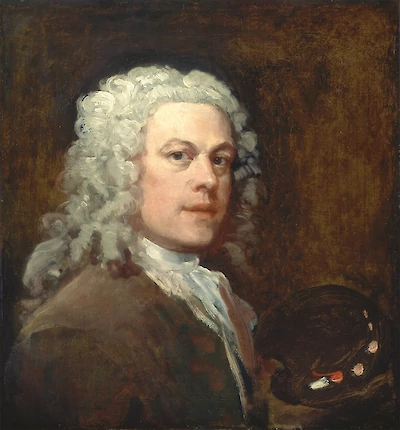

William Hogarth
A printmaker analyzes taste — and beauty comes out on top
1697 – 1764It may be imagined that the greatest part of the effects of beauty results from the symmetry of parts in the object, which is beautiful: but I am very well persuaded this prevailing notion will soon appear to have little or no foundation.
It may indeed have properties of greater consequence, such as propriety, fitness, and use; and yet but little serve the purposes of pleasing the eye, merely on the score of beauty.
We have, indeed, in our nature, a love of imitation from our infancy, and the eye is often entertained, as well as surprised, with mimicry, and delighted with the exactness of counterparts: but then this always gives way to its superior love of variety, and soon grows tiresome. If the uniformity of figures, parts, or lines, were truly the chief cause of beauty, the more exactly uniform their appearances were kept, the more pleasure the eye would receive; but this is so far from being the case, that when the mind has been once satisfied that the parts answer one another, with so exact a uniformity, as to preserve to the whole the character of fitness to stand, to move, to sink, to swim, to fly, etc. without losing the balance: the eye is rejoiced to see the object turned, and shifted, so as to vary these uniform appearances.
Thus the profile of most objects, as well as faces, are rather more pleasing than their full fronts.
Whence it is clear, the pleasure does not arise from seeing the exact resemblance which one side bears the other, but from the knowledge that they do so on account of fitness, with design, and for use. For when the head of a fine woman is turned a little to one side, which takes off from the exact similarity of the two halves of the face, and somewhat reclining, so varying still more from the straight and parallel lines of a formal front face: it is always looked upon as most pleasing. This is accordingly said to be a graceful air of the head.
It is a constant rule in composition in painting to avoid regularity. When we view a building, or any other object in life, we have it in our power, by shifting the ground, to take that view of it which pleases us best ; and in consequence of this, the painter, if he is left to his choice, takes it on the angle, rather than in front, as most agreeable to the eye; because the regularity of the lines is taken away by their running into perspective, without losing the idea of fitness: and when he is of necessity obliged to give the front of a building, with all its equalities and parallelisms, he generally breaks, as it is termed, such disagreeable appearances, by throwing a tree before it, or the shadow of an imaginary cloud, or some other object that may answer the same purpose of adding variety, which is the same with taking away uniformity.
If uniform objects were agreeable, why is there such care taken to contrast, and vary all the limbs of a statue?
The picture of Henry the Eighth, plate 4, would be -preferable to the finely contrasted figures of Guido or Correggio; and the Antinous’s easy sway, figure 1, plate 5, must submit to the stiff and straight figure of the dancing-master, figure 2, plate 5, and the uniform outlines of the muscles in figure 2, plate 6, taken from Albrect Durer’s book of proportions, would have more taste in them than those in the famous part of an antique figure, figure 1, plate 6, from which Michaelangolo acquired so much of his skill in grace.
In short, whatever appears to be fit, and proper to answer great purposes, ever satisfies the mind, and pleases on that account. Uniformity is of this kind. We find it necessary, in some degree, to give the idea of rest and motion, without the possibility of falling. But when any such purposes can be as well effected by more irregular parts, the eye is always better pleased on the account of variety.
How pleasingly is the idea of firmness in standing conveyed to the eye by the three elegant claws of a table, the three feet of a tea-lamp, or the celebrated tripod of the ancients!
Thus you see regularity, uniformity, or symmetry, please only as they serve to give the idea of fitness.